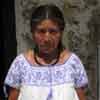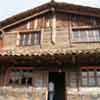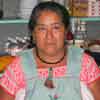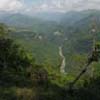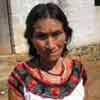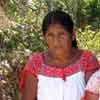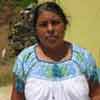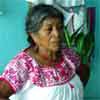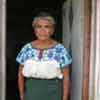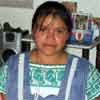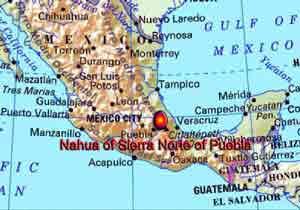 |
 |
 |
 |
|
||||||||
|
I was invited to document this municipality in Oct 2005 and returned in August 2006. With the help of the Municipal government, who gave us a truck, driver and Guillermo, the government official he is in charge of indigenous development. We set out to visit these towns. I was accompanied my Marco and Alicia from New York City. They help sponsor the trip. Thanks you all for your helping making these galleries possible. About the Nahua of this region Xochitlán de Vicente Suárez is a small (46 sq. kms) municipality, or district, located on the eastern slopes of the Sierra Madre Mountains in an area of Puebla State known as the Sierra Norte. In 2000 the district was home to 11,561 people, most of whom are Nahua indigenous people who speak a Uto-Aztecan language known as Highland Puebla Náhuatl. Deep canyons formed by rivers like the Apulco and Cuxateno that flow down to the Gulf of Mexico cut through the rugged tropical mountains of Xochitlán district. The panoramic views are spectacular. Most land in the district lies at an elevation between 1,000 and 1,200 Mts. The lowest spots (around 600 Mts.) are found in the valley of the Rio Zempoala whose floodplain bisects the district. Mount Ixtaczayo is the highest point at 1,900 Mts. Until recently, few roads connected Xochitlán to the rest of Mexico; this marginalization of the district and its people preserved many aspects of Nahua culture including production of a wide variety of traditional crafts and textiles. The earliest known settlements in the area date to 200-300 AD. In Aztec times, the region was part of the chiefdom of Nauzontla, a tributary province of the kingdom of Texcoco. The Spanish founded the colonial town of Xochitlán in 1542; the town is now the capital of the modern municipality. Its colonial church dates from 1633 and is dedicated to San Bartolomé Apóstol, whose feast day is celebrated on August 24 with a week of with traditional dances, special foods, and fireworks. Most Xochitecos are Catholics, but local religious beliefs and practices preserve many elements of traditional Nahua religion, such as belief in various "aires." Agriculture is the primary economic activity of most local Nahua people. The area receives rainfall all year long, so farmers can grow corn, beans and other subsistence crops. Coffee is grown as are a wide variety of tropical fruits, some of which go into making Xochitlán's famous fruit liquors. In years past, men left the district to work on the plantations of Veracruz or in major cities like Puebla and Mexico City, but now many head north to the US and send money back to their families in Xochitlán. Production of crafts for sale also supplements income from these other sources. In several communities women have founded coops to make and market beautiful traditional blouses. The necks and sleeves of the blouses are decorated with colorful bands worked in embroidery, crochet, and often glass beads. Typical designs include flowers, birds, and animals. Other local artisans weave baskets, make pottery, carve wooden masks and traditional furniture, and craft musical instruments including guitars and violins. Most local men wear western-style shirts and pants, but a few still wear the traditional white manta shirts and pants found throughout the eastern Sierra Madre. Xochitecas wear an amazing variety of beautiful blouses, which are seen in the village galleries. The blouses are generally worn with knee-length white skirts, aprons, and dark-colored rebozos. Quechquémitls are also part of the traditional woman's costumes. Narrative written for Mexican textiles project by Karen Ewell 2006 Thanks Karen Bob Freund
|
||||||||
|
||||||||
